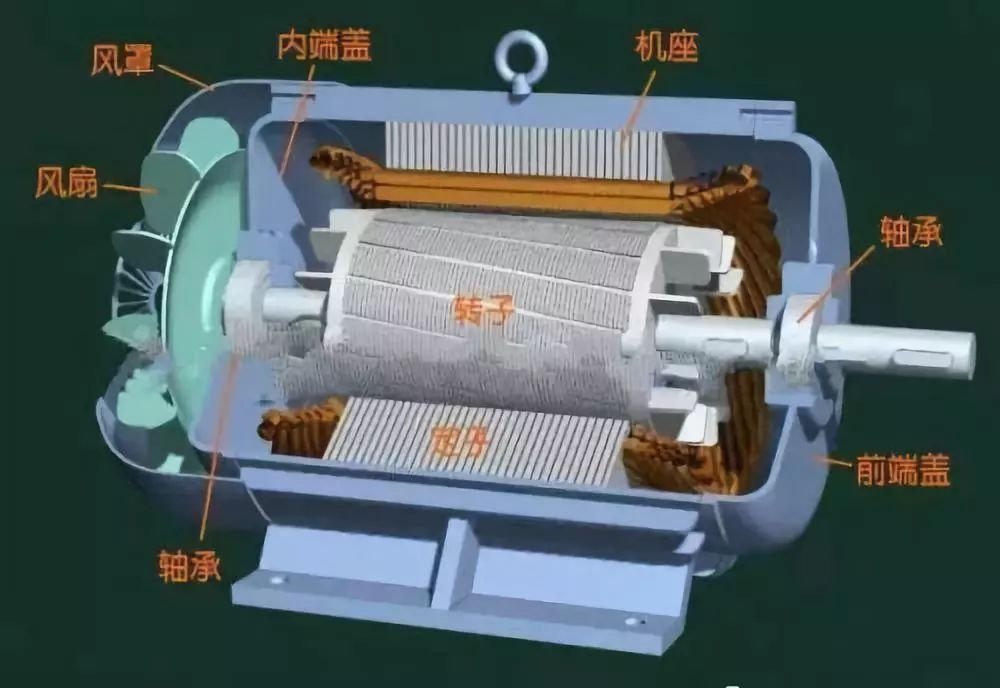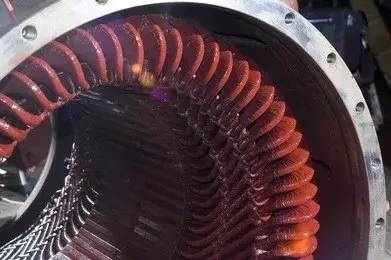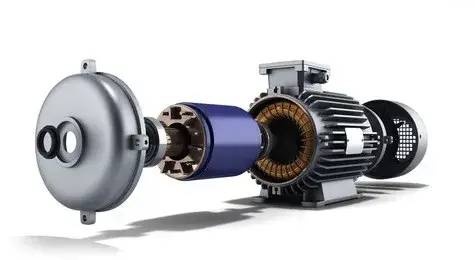![]()
New energy motor vs industrial motor
Overall, both electric vehicle motors and industrial motors are a type of motor, and the theory and method of classification and control are the same. Different from the industrial application of motors, the motors used in electric vehicles usually require frequent start and stop, fast dynamic response, low-speed constant torque operation, strong overload capacity, wide range of speed changes, and four-quadrant operation. While running the function, it should also meet the comfort when driving, the ability to adapt to the environment, etc.

Compared with the drivers for industrial motors, the drivers used for electric vehicle motors are quite different in size, working environment, reliability, power density, cooling methods, etc. The basic requirements for electric vehicle motor drive technology are summarized as follows:

1. Strict volume and weight requirements: Because it is a vehicle, the requirements in this aspect are prominent. Ordinary industrial motors do not have such strict requirements on volume size and weight, and generally meet industrial goals as the first purpose. Electric vehicles are different. The size and weight determine the power performance and driving experience of the car, and directly affect the quality of the product. Therefore, the difficulty of electric vehicle motors is to increase the power weight density and power volume density. The smaller, lighter, more powerful motor, the better.
2. Unique torque characteristics: ultra-high torque is required at start-up or low speed, and the vehicle speed can be pumped up to the desired speed in the fastest way. General industrial motors do not have such a high starting speed requirement. At the same time, sufficient power needs to be provided at high speeds so that the car can cruise at high speeds.
3. Wide speed range: the maximum speed may be 4 times or even higher than the base speed of the motor. At present, the best solution for electric vehicles is to omit the multi-speed gearbox and only use fixed-speed gear sets. In this way, the wider the speed range of the motor is required, the better. Take Tesla's Model S basic model as an example, the maximum RPM of the motor can reach 18,000 rpm, which is quite scary. This is a very big test for the power electronic governor.
4. Full-range efficiency requirements: Unlike electric locomotives powered by pantographs, electric vehicles are powered by batteries, and the cruising range depends entirely on the efficiency of the motor. For every 1% increase in motor efficiency, there is a corresponding 1% increase in cruising range. Therefore, the requirements for the efficiency of the motor are very high. To be higher is to win, and every bit of energy must be optimized.
5. High reliability and stability in the vehicle operating environment: a high degree of safety should be ensured in any case, especially in the controllable failure mode.
6. Low noise: including electromagnetic noise and audio noise, meeting the needs of vehicle electromagnetic compatibility and driving comfort.
7. Reasonable cost : Cost has always been a big obstacle to the popularization of electric vehicles.
The indicators for evaluating a motor drive system mainly include external characteristics (the relationship between maximum output torque and speed), constant power speed regulation range, and drive system efficiency distribution map (not the efficiency of a certain point, nor the efficiency of a single motor body or controller) , drive system power density and torque density, etc.
The following pictures clearly point out the relevant differences between automotive motors and industrial motors:

Comparison of the advantages and disadvantages of various new energy motors
The drive motor is one of the three main parts of the new energy vehicle. If the battery system is the blood of the electric vehicle and the electronic control system is the brain of the electric vehicle, then the motor system is the heart of the electric vehicle. In the new energy vehicle, the electric motor is used to replace the engine and under the control of the motor controller, the electric energy is converted into mechanical energy to drive the vehicle. It is the only driving device for pure electric vehicles.

At present, the classification of motors mainly includes four types: DC, AC induction, permanent magnet synchronous and switched reluctance. At present , permanent magnet synchronous motor is the mainstream type of motor due to its better performance . The price of the AC asynchronous motor is moderate, but the performance is slightly inferior, and it is used by some manufacturers in the United States and China. The main advantage of the switched reluctance motor lies in its lower price, but at the same time there are technical problems of noise and vibration . If these problems can be solved, the switched reluctance motor will have a large market. At this stage, the drive motors suitable for new energy vehicles mainly include permanent magnet synchronous, AC asynchronous and switched reluctance. Because of their different characteristics, each has its application occasions.
The permanent magnet synchronous motor is small in size, light in weight, high in power density, high in reliability, high in speed regulation accuracy, and fast in response; but its maximum power is low and its cost is high. Since the permanent magnet synchronous motor has the highest power density, its working efficiency can reach up to 97%, and it can output the maximum power and acceleration for the vehicle. Therefore, it is mainly used in new energy passenger vehicles that require the highest energy volume ratio.AC asynchronous motors are low in price and reliable in operation; however, their low power density, complex control, and small speed range are inherent limitations. The price advantage makes it widely used in new energy buses.Switched reluctance motors are low in price, simple and reliable in circuit, and wide in speed regulation range; however, they have large vibration and noise, complex control system, and will generate a large pulse current to the DC power supply, and are used in large passenger cars.Comparison of drive motor performance indicators
New energy vehicle drive motors are developing toward the goals of: small and lightweight; high efficiency; better torque characteristics; long service life, high reliability; low noise; low price. Permanent magnet synchronous motors become the mainstream trendAt present, the use of permanent magnet synchronous motors in China's new energy vehicles accounts for more than 90%, and AC asynchronous motors are mainly used by American car companies headed by Tesla and some European companies. On the one hand, this is related to Tesla’s initial choice of technology path. AC induction motors are cheap, and their large size does not hinder American cars ; Excellent.The most widely used motors for new energy vehicles in other countries including China and Japan are still permanent magnet synchronous motors . Suitability to national road conditions is the main factor. Permanent magnet synchronous motors can still maintain high efficiency during repeated start and stop, acceleration and deceleration, and are the best choice for working conditions with limited high-speed road networks.In addition, my country's rare earth reserves are abundant, and Japan's rare earth permanent magnet industry has a supporting foundation is also an important factor. Automobile companies such as Toyota, Honda, and Nissan in Japan basically use permanent magnet synchronous motor drive systems, such as Toyota's Prius and Honda's CIVIC. Because in Japan, there are many companies that supply rare earth magnets used in permanent magnet motors, and most of the cars run at low and medium speeds, so it is more appropriate to use permanent magnet synchronous motors with higher efficiency during acceleration and deceleration.Japan is a world leader in the development of hybrid vehicles, the most famous of which is the Toyota Prius.On the whole, new energy vehicle motors have high technical requirements, and permanent magnet synchronous motors have the most advantages. Drive motors are one of the three core components of new energy vehicles. Compared with traditional industrial motors, drive motors for new energy vehicles have higher technical requirements. From the perspective of comprehensive performance, the permanent magnet synchronous motor has the most advantages and can better represent the development direction of new energy vehicle drive motors.Since China has extremely rich rare earth reserves and the motor technology is close to the world's advanced level, it is expected that permanent magnet motors will occupy the motor market of China's new energy vehicles for a long time. Motor development technology trendIn general, permanent magnet synchronous motors have distinct advantages over induction motors. However, the current cruising range of pure electric vehicles is bound to be an extremely important indicator, and the high efficiency of permanent magnet synchronous motors can better improve the cruising range. Moreover , the successful development of NdFeB permanent magnets with high heat resistance and high magnetic properties and the further development and improvement of power electronic components have further improved the development of rare earth permanent magnet synchronous motors. But as far as the current development trend is concerned, the permanent magnet synchronous motor seems to have a better prospect. With the rapid development of new energy vehicle drive technology, many new structures or new concept motors have been put into research. Among them, the new permanent magnet brushless motor is one of the most promising motors at present, including hybrid excitation type, hub type, double stator type, memory type and magnetic gear compound type. In addition, amorphous motors have also begun to enter the field of new energy vehicles. As a new generation of high-performance motors, their own advantages will definitely play a huge role in promoting the development of the new energy vehicle industry.
































 XINDA
XINDA